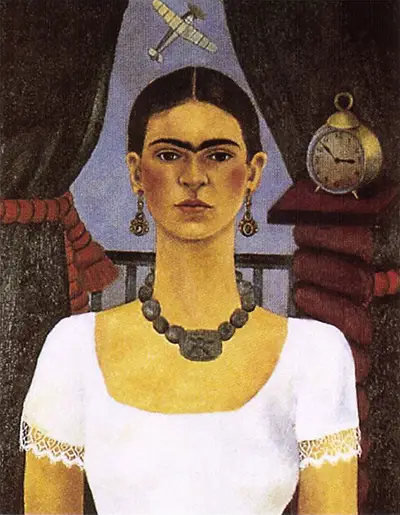In the self-portrait Time Flies, Kahlo positions herself in the centre of the frame. She stares directly at the viewer with a wide-eyed, serene expression, and her signature brow is painted to resemble an open-winged bird, a subtle nod to the painting's title. To the right of the subject is a stack of books topped with a clock that reads 2:43. The significance of the time is not widely known. Above her head is an airplane pointing in a north-easterly direction. The aircraft also resembles an open-winged bird in flight. Heavy green curtains tied back with red ropes give way to a bright blue sky portending ebullience and hope.
In the portrait, Kahlo is wearing traditional Mexican clothing and jewellery. Her hair is parted down the middle and pinned up. Rouged cheeks add colour and suggest health and contentment. These uplifting notes are a departure from an earlier self-portrait that has her in more formal clothing.
Frida Kahlo painted Time Flies in 1929, the year she wed another celebrated Mexican artist, Diego Rivera. His influence on her art and eye is evident in this work. In previous pieces, Kahlo emulated Renaissance painters. In this work, however, she uses a more traditional Mexican folk style, preferred by Rivera, which incorporated bold colours and techniques used in the nativist school. From this point forward, Kahlo hues closer to this aesthetic than the more European-influenced forms of her earlier pieces. The New York branch of famed auction house Sotheby's sold the piece in the summer of 2000 for five million dollars to an American collector. At the time of the sale, Kahlo became the highest selling Latin American artist in history.

